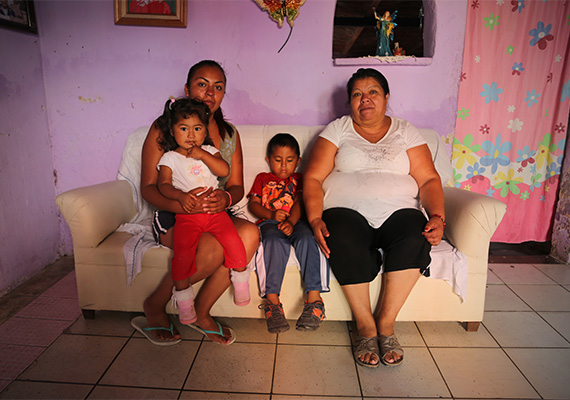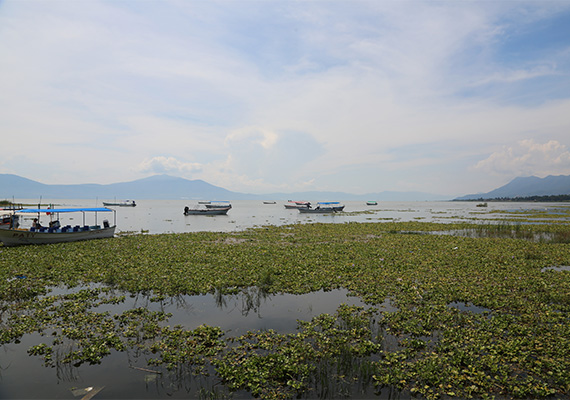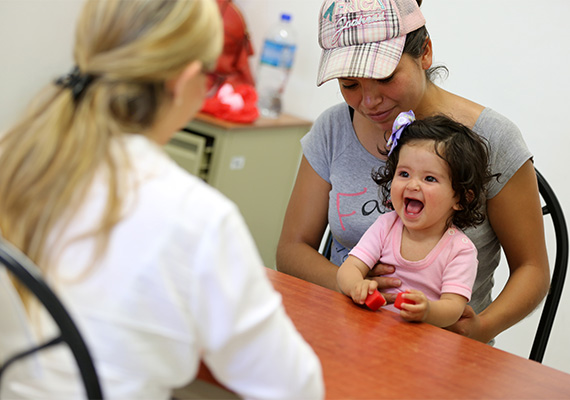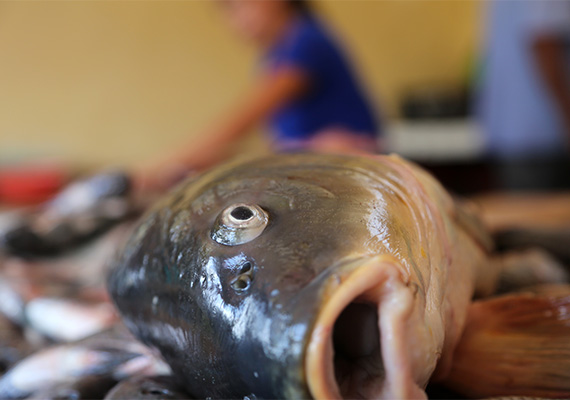The mystery of the lake
Harvard researchers probed whether fish in Mexican area were contaminated — and were harming mothers, children
Fourth in a series on Harvard’s deepening connections to Mexico.
CHAPALA, Mexico — Juan de Dios, age 4, was playing outside when his mother, Maria Dolores León Torres, called him back into the living room of their compact stone house. Glumly, he sat on the sofa between his mother and grandmother. On the pink wall were pictures of Jesus Christ and the Virgin Mary, and another of Maria Dolores on her wedding day.
Even before he was born, Juan de Dios was the subject of an important local public health study. Conducted by researchers at Harvard University and elsewhere, the survey asked a basic question: Is it safe for pregnant mothers to eat fish from nearby Lake Chapala? Earlier studies had hinted that its fish — a key source of protein for the poor — contained high levels of methyl mercury, a neurotoxin linked to long-term cognitive and behavioral deficits in children. Investigators needed to determine if that was true to safeguard public health locally.
“It wasn’t easy,” said Harvard’s Enrique Cifuentes of executing the complex study, which began as a pilot in 2007 and reached full bloom between 2010 and 2013. “There were many concerns. These ‘risk communications’ are inherently volatile.”
For a culinary culture in which fish are fundamental, the investigation required hurdling local fear and skepticism to recruit health workers, enlist Mexican university researchers, and survey pregnant women from communities surrounding the lake.
Early outreach proved fruitful in winning local families’ trust. Leon Torres was one of 300 women recruited for a study of their first trimester of pregnancy. “All our lives we’ve eaten fish, because my father was a fisherman,” she said. “We’ve never gotten ill.”
The mothers provided their medical histories and gave samples of their hair, blood, and urine. They agreed to clinic visits, and after giving birth to have their children undergo complex developmental evaluations.
“We tracked their eating habits, rhythms of life, and how exposed they were to contaminants,” said Guadalajara native Sofia Reynoso Delgado, an investigator with Proyecto Chapala and chief community coordinator for collecting data from the mothers.
Diving into Lake Chapala

Maria Dolores León Torres (left), at home with her family in the La Vista neighborhood of Chapala, Mexico. She and her son Juan de Dios, age 4 (center), were part of a Harvard study investigating suspected contamination in fish from Lake Chapala. “We haven’t ever gotten ill,” she said. Photos by Ned Brown/Harvard Staff

A shoreline view of Lake Chapala, the largest freshwater lake in Mexico and a breadbasket of protein in a region where 60 percent of 300,000 citizens live below the poverty line.

In a health clinic in Jocotepec, Mexico, 11-month-old Genesis laughs at the sound of plastic blocks — part of a test series called the Bayley Scales of Infant Development used to assess language, cognition, and motor skills in children to age 3. In the Harvard study, 167 such tests were done.

A fresh-caught carp gasps and blinks in a fish market in Chapala, Mexico. The study identified carp as the fish that women of childbearing age should avoid.

Ramon Mendoza (center) with his family at the fish market stand he founded in Chapala, Mexico.
Environmental mission, ethical imperative
Proyecto Chapala had an environmental mission that was wrapped within an ethical imperative, said Reynoso. “From the moment a mother is giving life, [she] has the right to a healthy pregnancy,” she said. From that first study on fish, propelled in part by Harvard researchers, a constellation of projects has since grown, all centered on children and environmental conditions in the region, all pointed toward improving daily life for area inhabitants, bit by bit.
In Chapala’s La Vista neighborhood, cobbled narrow streets are lined on each side with family-built houses of rough brick. Young women walk past, swinging telltale blue pails that denote a daily trip to collect free milk from a local social center. Plastic bags are nailed high on trees or hooked over fences, a way of keeping rodents away from garbage.
La Vista, with its namesake beautiful views and impoverished residents, is like much of Mexico: lovely and poor. Half of all Mexicans live below the poverty line. Nationally, the median household income is about $260 a month. In the Lake Chapala region, home to 300,000 people, 60 percent are poor, and 13 percent live in extreme poverty.
In the face of such economic hardship, people seem both fatalistic and big-hearted. Retired bus driver Ernesto Meza Valdivia leaned on a park balustrade at La Vista’s highest point, looking down on a picturesque tumble of pastel houses that led to the glittering lake below. “Panoramica Chapala,” he said, with church bells tolling behind him. “It is beautiful. God’s hand is in everything.”
In towns along the lake, God’s hand has meant abundant fish. The first panel of a historical mural on a busy street in Chapala depicts early natives hauling their catches from the lake in tall baskets. Three of the mural’s eight panels are about fishing.
Cifuentes, a physician who had a family practice in rural Mexico before earning a Ph.D., is principal research scientist in the Department of Environmental Health at the Harvard T.H. Chan School of Public Health. Collaborating with him in the mercury study were onetime pediatrician Felipe Lozano-Kasten, now a professor of public health at the University of Guadalajara, and Leonardo Trasande of the Department of Pediatrics at the New York University School of Medicine, who tracked hair, blood, and urine samples. Over two years, HSPH neurologist David C. Bellinger, a professor of neurology at Boston Children’s Hospital, trained a cohort of Mexican psychologists to assess development in toddlers.
At the heart of the investigation was a culture centered on the abundance of the 700-square-mile lake, the largest freshwater body in Mexico. For centuries, families have relied on cod, tilapia, and tiny charales as a main source of inexpensive protein.
Lake Chapala’s professional fishermen, called pescadores, set out in their boats at 4 every morning to drag in a catch with nets or harvest fish from farms they block off in the 14-foot water. By 7 or 8 a.m. the fish are in local markets, so fresh they are still flopping and gasping on iced tables.
Some customers prefer buying from fishermen directly, and returning home to prepare the fish for the day’s meals. On a narrow road near the town square in Jocotepec, a woman sat in the shade of a tree, filleting fish that lay wriggling in a wheelbarrow. In half an hour, the fish would be ceviche, bits of raw fillet mixed with lime, diced onion, salt, and cilantro. Or they would be breaded and fried whole.
At one sitting, said boatman Jose Francisco Castro Estrada, it’s routine for him to eat three or four helpings of tilapia.
Fish from the lake also supply most of the income for fish merchants in towns like Chapala, where shoppers at a second-floor fish market milled at tables heaped with the morning’s catch. On a good day, said Juan Ramon Mendoza Campos, a burly salesman, he will sell 130 pounds of local fish.
So the mercury study was a concern for residents of the lake basin, possibly threatening two main engines of life: money and food.
Study proved reassuring
In the end, though, the study proved reassuring. In a paper to be published in a journal this fall, Cifuentes and his co-authors aver that eating Lake Chapala white fish like tilapia and charales at least once a week is healthy for women of reproductive age and for pregnant mothers. Other people can eat fish more often than that.
“That reflects a global consensus on the consumption of fish during pregnancy,” said Cifuentes, who for several years traveled to the lake region, often with Harvard and Guadalajara graduate students in tow. They helped collect fish, lake sediments, and medical samples.
As for the study’s developmental testing, it revealed no negative effects on cognition, language, or motor skills among infants. That result, said University of Guadalajara psychologist Leonor Lozano, was “very positive news for the people of the communities surrounding Lake Chapala.”
But the study did say that women of childbearing age should avoid eating carp, carnivorous fish, and bottom feeders that may contain elevated levels of mercury. In hundreds of fish assayed, said Cifuentes, only carp — and just a few of those — showed risky levels of mercury.
“Fortunately, we have very good news,” he said of the three-year study’s bottom line. “Keep eating fish. But women of childbearing age should eat only the right ones.”
The carp breed in Lake Chapala’s most polluted area, an effluvial patch near the mouth of the Rio Lerma, which exits into the lake after starting near Mexico City and coursing through 470 miles of landscape. Lining the river basin along the way are farms, but also polluting industries related to petrochemicals, meat, beverages, and leather goods. Environmentalists use a Spanish phrase for Lerma, “water for crying.”
Water levels in Lake Chapala affect pollution levels and fishing. If they are low, toxins become more concentrated, and fishing is poor. The lake’s water levels are determined by the weather and by how much water the city of Guadalajara draws off. Heavy rain in September brought Chapala to about 80 percent of its optimal water level.
Even when the catch is abundant, eating local white fish just once a week doesn’t sound like enough for pregnant women. But study data showed there are abundant local sources of protein beyond fish, including chicken, pork, and beans. Luckily, vegetables and fruits are also relatively cheap and abundant in the Lake Chapala watershed.
Maria Clara Claro Moreno, the mother of 4-year-old Juan Pablo, lives in La Vista and also participated in the study, taking lessons from it. Like other mothers, she made adjustments in her family’s cooking and eating. Clara doesn’t make fish broth anymore, and “even though the head is our favorite, and we used to argue over who got to eat it,” she said, “we try not to eat it anymore.”
But the mercury investigation was never just about suspected contamination in fish. It had a wider set of missions: to empower local citizens, share environmental lessons, and educate children to manage the future. In addition, it aimed to prepare a group of collaborators who are decision-makers, citizens, and academics, and who would share what they know and learn. The groups “discuss the realities,” said Lozano-Kasten, “and we build a better reality together.”
Presentations to communities
In 2010, Proyecto Chapala started a weekly series of hour-long presentations in six communities along the lake, discussing environmental contaminants, strategies for minimizing exposure, and other issues related to the heart of the project: protecting children and their mothers. Few men attended. Proyecto Chapala researcher Gabriela Luna Hernandez, a master’s degree student in nutrition at the University of Guadalajara, said, “The mother is the center of food, the center of health, and the center of culture.”
The classes became the foundation for Taller Medio Ambiente e Infancia, a three-month, 40-hour program in environmental health, with certificates awarded at the end. “It’s a way of empowering the mothers,” said Lozano-Kasten, who ran many of the sessions. It’s also a way of transferring academic knowledge into a practical arena, like childrearing. A scientist “has stuff published in a journal,” he said, which local people never read. “Knowledge has to be useful.”
By 2011, the educational outreach had expanded to installing EcoSan dry sanitation toilets and enhanced hand-washing facilities in four area primary schools serving about 1,000 children. The effort was a way to conserve water, to teach children basic hygiene habits, and to impart environmental lessons.
“Schools are a good place to build principles,” said Cifuentes, including an appreciation of sanitation systems that may protect Lake Chapala by eliminating discharges into it. “We want to teach children that water is not for conveying waste.”
Instead, that waste is put to work. At the primary school in El Molino, a hillside town of 1,300 far above the lake, janitor Benjamin Delgadillo explained how solid waste in the toilets is dusted with ash or sawdust and stored for several months, and how it emerges as compost. Urine is captured too, diluted, and decanted, and finally repurposed as fertilizer.
Before dry sanitation toilets were installed, the school used 3,000 liters of water a day, pumped far uphill from the lake at great cost or trucked to the site. After four Eco-San toilets were installed, said school director Mayra Berenice Garcia Ramirez, water use fell to 700 liters a day.
The school also now captures rainwater in three 3,000-liter cisterns, said Ana Karina Garcia Suarez, a University of Guadalajara physician with a master’s degree in environmental health. She is chief environment educator for primary schools in the Chapala region. Her job, new since the study began, is one of the ways Proyecto Chapala continues to improve life on the lake. These are initiatives “beyond the clinic experience,” said Lozano-Kasten, and that go “deeper into the local culture.”
On the scholarly side, there are other studies planned for the Chapala region, including one on exposure to pesticides, another on the long-term effects of plastic leachates, and a third on pregnancy rates among adolescents in the region. With the mercury study completed, said Lozano-Kasten, “the systems and methods are in place” for future investigations.
“If you reach the children and their mothers,” said Lozano-Kasten, “the project has succeeded.”
Harvard President Drew Faust, University administrators, and faculty members are in Mexico this week for a series of meetings, tours, and alumni events. Read about the trip here.





